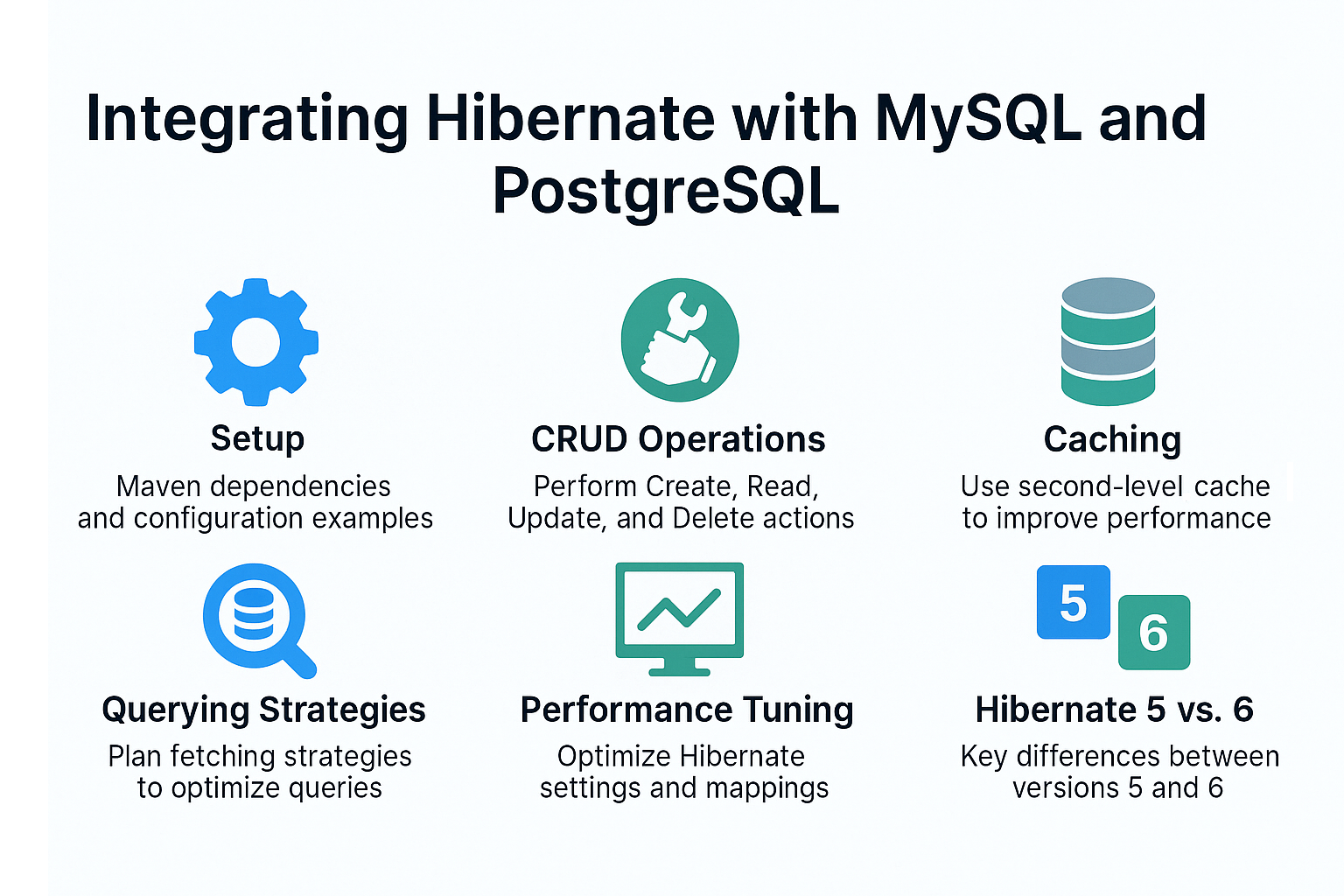When building enterprise applications, one of the biggest challenges developers face is interacting with relational databases in a clean and efficient way. Writing raw SQL for every database interaction often results in boilerplate code, increased complexity, and a higher chance of bugs.
Hibernate is a popular Object-Relational Mapping (ORM) framework for Java that bridges this gap. It allows developers to map Java objects to database tables and perform CRUD (Create, Read, Update, Delete) operations seamlessly. Instead of focusing on SQL, developers can work with objects while Hibernate takes care of generating optimized queries under the hood.
In this tutorial, we’ll explore how to integrate Hibernate with MySQL and PostgreSQL, covering setup, CRUD operations, querying strategies, caching, performance optimization, and real-world integration with Spring Boot.
1. Hibernate Basics
What is Hibernate?
Hibernate is an ORM framework that allows developers to map Java classes to relational database tables using annotations or XML configurations. Its primary goals are:
- Eliminate boilerplate JDBC code
- Handle complex relationships between entities
- Provide caching for performance improvements
- Abstract database-specific SQL differences
Why MySQL and PostgreSQL?
- MySQL: Widely used in web applications for speed and scalability.
- PostgreSQL: Feature-rich, supports advanced SQL features like JSON, full-text search, and stored procedures.
2. Project Setup
We’ll use Maven for dependency management.
pom.xml for MySQL
<dependency>
<groupId>mysql</groupId>
<artifactId>mysql-connector-java</artifactId>
<version>8.0.33</version>
</dependency>
<dependency>
<groupId>org.hibernate.orm</groupId>
<artifactId>hibernate-core</artifactId>
<version>6.3.0.Final</version>
</dependency>
pom.xml for PostgreSQL
<dependency>
<groupId>org.postgresql</groupId>
<artifactId>postgresql</artifactId>
<version>42.7.1</version>
</dependency>
<dependency>
<groupId>org.hibernate.orm</groupId>
<artifactId>hibernate-core</artifactId>
<version>6.3.0.Final</version>
</dependency>
3. Hibernate Configuration
Hibernate requires a configuration file (hibernate.cfg.xml):
Example for MySQL
<!DOCTYPE hibernate-configuration PUBLIC
"-//Hibernate/Hibernate Configuration DTD 3.0//EN"
"http://hibernate.sourceforge.net/hibernate-configuration-3.0.dtd">
<hibernate-configuration>
<session-factory>
<property name="hibernate.connection.driver_class">com.mysql.cj.jdbc.Driver</property>
<property name="hibernate.connection.url">jdbc:mysql://localhost:3306/hibernate_demo</property>
<property name="hibernate.connection.username">root</property>
<property name="hibernate.connection.password">password</property>
<property name="hibernate.dialect">org.hibernate.dialect.MySQL8Dialect</property>
<property name="hibernate.hbm2ddl.auto">update</property>
<property name="hibernate.show_sql">true</property>
<property name="hibernate.format_sql">true</property>
</session-factory>
</hibernate-configuration>
Example for PostgreSQL
<hibernate-configuration>
<session-factory>
<property name="hibernate.connection.driver_class">org.postgresql.Driver</property>
<property name="hibernate.connection.url">jdbc:postgresql://localhost:5432/hibernate_demo</property>
<property name="hibernate.connection.username">postgres</property>
<property name="hibernate.connection.password">password</property>
<property name="hibernate.dialect">org.hibernate.dialect.PostgreSQLDialect</property>
<property name="hibernate.hbm2ddl.auto">update</property>
<property name="hibernate.show_sql">true</property>
</session-factory>
</hibernate-configuration>
4. Entity Mapping with Annotations
Let’s create a simple User entity.
import jakarta.persistence.*;
@Entity
@Table(name = "users")
public class User {
@Id
@GeneratedValue(strategy = GenerationType.IDENTITY)
private Long id;
@Column(nullable = false)
private String name;
@Column(unique = true, nullable = false)
private String email;
// Getters and Setters
}
5. Hibernate Utility Class
import org.hibernate.SessionFactory;
import org.hibernate.cfg.Configuration;
public class HibernateUtil {
private static final SessionFactory sessionFactory;
static {
try {
sessionFactory = new Configuration().configure("hibernate.cfg.xml").buildSessionFactory();
} catch (Throwable ex) {
throw new ExceptionInInitializerError(ex);
}
}
public static SessionFactory getSessionFactory() {
return sessionFactory;
}
}
6. CRUD Operations
Create (Insert)
import org.hibernate.Session;
import org.hibernate.Transaction;
public class UserDAO {
public void saveUser(User user) {
Transaction transaction = null;
try (Session session = HibernateUtil.getSessionFactory().openSession()) {
transaction = session.beginTransaction();
session.persist(user);
transaction.commit();
} catch (Exception e) {
if (transaction != null) transaction.rollback();
e.printStackTrace();
}
}
}
Read (Select)
public User getUserById(Long id) {
try (Session session = HibernateUtil.getSessionFactory().openSession()) {
return session.get(User.class, id);
}
}
Update
public void updateUser(User user) {
Transaction transaction = null;
try (Session session = HibernateUtil.getSessionFactory().openSession()) {
transaction = session.beginTransaction();
session.merge(user);
transaction.commit();
} catch (Exception e) {
if (transaction != null) transaction.rollback();
}
}
Delete
public void deleteUser(Long id) {
Transaction transaction = null;
try (Session session = HibernateUtil.getSessionFactory().openSession()) {
transaction = session.beginTransaction();
User user = session.get(User.class, id);
if (user != null) session.remove(user);
transaction.commit();
} catch (Exception e) {
if (transaction != null) transaction.rollback();
}
}
7. Querying with Hibernate
HQL
List<User> users = session.createQuery("FROM User", User.class).list();
Criteria API
CriteriaBuilder cb = session.getCriteriaBuilder();
CriteriaQuery<User> cq = cb.createQuery(User.class);
Root<User> root = cq.from(User.class);
cq.select(root).where(cb.equal(root.get("name"), "John"));
List<User> result = session.createQuery(cq).getResultList();
Native SQL
List<Object[]> users = session.createNativeQuery("SELECT * FROM users").list();
8. Performance Considerations
- Lazy Loading: Fetch relationships only when needed (like ordering food only when hungry).
- Caching: Use first-level (Session) and second-level (Ehcache, Infinispan) caches.
- Batch Fetching: Avoid N+1 select problems.
9. Real-World Integration with Spring Boot
In Spring Boot, Hibernate is integrated via Spring Data JPA. You only need:
spring.datasource.url=jdbc:mysql://localhost:3306/hibernate_demo
spring.datasource.username=root
spring.datasource.password=password
spring.jpa.hibernate.ddl-auto=update
spring.jpa.show-sql=true
And a simple Repository interface:
public interface UserRepository extends JpaRepository<User, Long> {}
📌 Hibernate Version Notes
- Hibernate 5
- Relies on legacy
javax.persistencenamespace. - SessionFactory configuration using XML or programmatic API.
- Relies on legacy
- Hibernate 6
- Migrated to
jakarta.persistencepackage. - Improved SQL support and enhanced Criteria API.
- Better integration with modern databases (MySQL 8, PostgreSQL 14+).
- Migrated to
10. Common Pitfalls
- N+1 Problem: Caused by fetching child entities in loops → Fix with
JOIN FETCH. - Eager Fetching Everywhere: Can lead to performance bottlenecks.
- Ignoring Transactions: Always manage transactions properly.
11. Best Practices
- Use DAO or Repository pattern.
- Enable second-level caching for performance.
- Log queries during development (
hibernate.show_sql=true). - Always close sessions properly.
12. Conclusion and Key Takeaways
- Hibernate simplifies database access by mapping objects to tables.
- MySQL is great for speed, PostgreSQL for advanced features.
- CRUD operations become intuitive and object-oriented.
- Caching and lazy loading drastically improve performance.
- Hibernate 6 introduces modern APIs and improved SQL handling.
13. FAQ
1. What’s the difference between Hibernate and JPA?
JPA is a specification; Hibernate is an implementation of JPA with extra features.
2. How does Hibernate caching improve performance?
It reduces redundant SQL queries by storing entities in memory.
3. What are the drawbacks of eager fetching?
It loads all associated data immediately, leading to performance issues.
4. How do I solve the N+1 select problem in Hibernate?
Use JOIN FETCH or batch fetching strategies.
5. Can I use Hibernate without Spring?
Yes, you can configure Hibernate manually using XML or Java config.
6. What’s the best strategy for inheritance mapping?@Inheritance(strategy = InheritanceType.JOINED) balances normalization and performance.
7. How does Hibernate handle composite keys?
Using @Embeddable and @EmbeddedId annotations.
8. How is Hibernate 6 different from Hibernate 5?
Hibernate 6 adopts Jakarta namespace, enhanced SQL, and new APIs.
9. Is Hibernate suitable for microservices?
Yes, but lightweight alternatives like JOOQ or MyBatis may be better in some cases.
10. When should I not use Hibernate?
When performance-critical queries require fine-tuned SQL or when using NoSQL databases.
